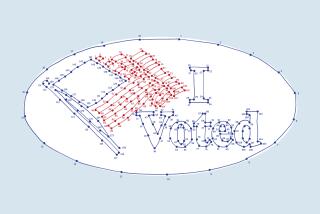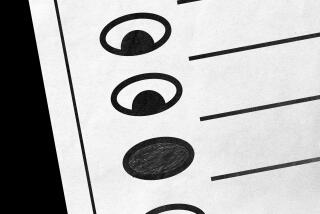L.A., brace for balloting
It’s been a rarity in Los Angeles: a year without elections. Yes, there has been the occasional special election in one district or another to fill vacancies in Congress and on the City Council. But the six council incumbents who were up for new terms locked up their reelections in the March 2011 city primary, as did the leading candidate in a seventh race, and there was no need for May runoffs. Voters here have seen little action since then.
The respite is over. Angelenos face three major elections in rapid succession, beginning with the June 5 primary, followed by the Nov. 6 presidential election and, just four months later, the city’s selection of a mayor, city attorney, controller, half the City Council, half the school board and half the community college board. Campaigns for all three elections — not merely for city, county, school, state and federal offices but also for a heavy load of ballot measures — are well underway. It’s time for voters to warm up too: Voting begins in fewer than 60 days, as half of all ballots are again likely to be cast early, by mail, as much as a month before election day.
The marquee item on the June ballot may be the Republican presidential primary, especially if Rick Santorum and Newt Gingrich continue to give Mitt Romney a run for his ample money in other state primaries. But even without the White House aspirants, our ballot is packed with weighty items. Seven candidates are competing to become Los Angeles County district attorney, and it’s the first time that position has been open since 1964 — the first time in 48 years, in other words, that voters will put someone in that office who didn’t defeat the incumbent or first get appointed to the post by the Board of Supervisors. The voters’ decision in that race will have a huge impact on the use of the death penalty; on whether more or fewer juvenile offenders are tried and punished as adults; on whether the criminal justice system is redeployed in the quest for smarter alternative sentencing and restorative justice; on whether crooked politicians as well as violent criminals will be in the sights of prosecutors; on whether environmental injustices will be treated as crimes; and on whether we continue to have a competent legal office that helps to remove dangerous criminals from our communities.
Despite a new California law that moves all statewide ballot measures to the November election, there remain two measures that got in under the wire for June: Proposition 28 would rejigger legislative term limits, and Proposition 29 would impose a tobacco tax to raise money for cancer research. We narrowly averted a city initiative to require condom use on adult film sets when the City Council decided to pass the substance of the measure into law, and a similar county measure won’t come our way until November, if at all. But there are two county ballot measures in June: One would extend a hotel occupancy tax and the other would re-up a landfill business license tax.
The primary ballot also includes half a dozen judicial races and a majority of the county Board of Supervisors seats. The board isn’t exactly up for grabs, given that few challengers are running and that no one has ousted a sitting member since 1980. But three of the five current members are on the ballot (including Michael D. Antonovich, who was that successful challenger 32 years ago), and two of them are seeking what would be their final terms. County government is reaching the conclusion of one era and beginning another.
And then there are dozens of congressional and state legislative races, many of which are made more complex — and more interesting — by twin California reforms dealing with political partisanship. Redistricting by a new citizens commission in several cases pits incumbent against incumbent and has accelerated the retirement of several long-serving members of Congress, mostly on the Republican side. Under the new top-two primary system, the two candidates who get the highest vote totals in a June congressional, Assembly or state Senate race will face off against each other in the Nov. 6 general election, even if both are members of the same party, and even if the top candidate gets 90% of the vote and the No. 2 candidate gets 5%. Candidates may try to reject their party labels as they seek support from the moderate middle, or they may cling ever more tightly to party backing and party money. All Californians are part of the experiment.
The Times’ editorial page takes seriously its responsibility to inform and engage readers on election issues. We expect to offer our recommendations and our reasoning for the statewide and county ballot measures, for the judicial races and for district attorney. And we are picking out several of the most consequential congressional and legislative races for special focus. We have our eye on the GOP primaries here and elsewhere and will continue to weigh in heavily on those races as they proceed. Although we reserve the right to let some races go — it’s not clear, for example, that there will be much to say about Democratic Sen. Dianne Feinstein’s primary race — our instinct is to jump in, check things out, rattle some cages and offer our opinions.
But November and the following March are right around the corner, and while we’re grappling, along with all Californians, with the June primary, we’re knee-deep in November ballot measures and 2013 city election issues. Look in coming days for editorials on possible November initiatives to end California’s death penalty and to increase taxes.
More to Read
A cure for the common opinion
Get thought-provoking perspectives with our weekly newsletter.
You may occasionally receive promotional content from the Los Angeles Times.










